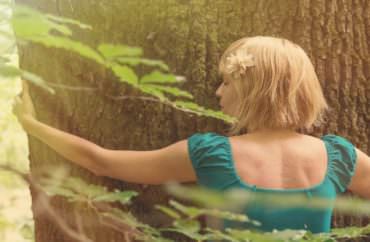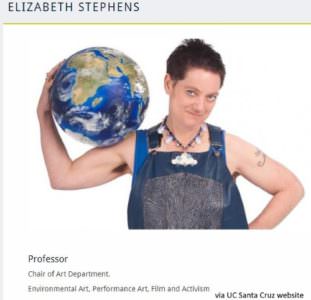LEFT WING LOONS
See other LEFT WING LOONS Articles
Title: ‘Ecosexual’ professor spurs movement: Have sex with Earth to save it
Source:
The College Fix
URL Source: https://www.thecollegefix.com/post/36330/
Published: Sep 5, 2017
Author: William Nardi - University of Massachuse
Post Date: 2017-09-06 09:46:49 by Deckard
Keywords: None
Views: 1631
Comments: 11
Earth as lover, not mother Four years ago, when art Professor Elizabeth Stephens filmed the documentary “Ecosexual Love Story,” in which she and her partner licked trees, played with mud, and made love with the environment while naked, the term “ecosexuality” was still somewhat unknown. But a lot has happened since then, and ecosexuality isn’t such a mystery anymore — Google trends show interest in the term has increased exponentially over the last 12 months, seemingly exploding. That interest can be traced in part back to Stephens, a UC Santa Cruz professor and one leader in the movement that melds art, sex and environmentalism, a la having sex with a tree or marrying the ocean. Stephens, chair of the art department at the public university, is set to debut her latest documentary “Water Makes Us Wet.” Its premiere is slated for this week in Germany as part of a large art exhibition. Over the summer, Stephens also co-led an “Ecosex Walking Tour” in Germany that offered “25 ways to make love to the Earth, raise awareness of environmental issues, learn ecosexercises, find E-spots, and climax with the planetary clitoris,” according to a description of the event on UC Santa Cruz’s website. In May, she helped lead a two-day “Ecosex Symposium” at the public university. The event included workshops given by professors such as “Decolonizing Settler Sexuality” and “Academic Freedom In An Ecosexphobic World.” Earlier this year, she also co-authored the book “The Explorer’s Guide to Planet Orgasm: for every body,” which explores various types of orgasms and how to “discover” them, its online description states. All this has not gone unnoticed. The concept was recently featured in Teen Vogue, for example, which told its young readers about a concept called “Grassilingus,” which was accompanied by a description of a musician laying facedown in grass and licking it. “Whether it’s masturbating with water pressure, using eco-friendly lubricant, or literally having sex with a tree — a person of any sexual proclivity who finds eroticism in nature, or believes that making environmentalism sexy will slow the planet’s destruction, can be ecosexual,” the magazine explained in its June article. A feature published in August in Women’s Health Magazine added to the description. “We chatted with Annie Sprinkle, Ph.D., and Beth Stephens, Ph.D., performance artists, ecosexual experts, and the authors of ‘The Explorer’s Guide to Planet Orgasm’ to get the scoop on this trend. They describe being ecosexual as this: ‘you don’t look at the Earth as your mother, you look at it as your lover.’ You also experience nature ‘as sensual, erotic, or sexy.’ This could mean anything getting off while writhing around naked in the mud to simply getting joy out of doing it in a hot tub or going on a naked hike,” the magazine reported. Last November, a report it Breitbart also spotted the emerging trend. It cites part of Sprinkle’s and Stephens’ self-described “manifesto.” The document states: “We make love with the Earth. We are aquaphiles, teraphiles, pyrophiles and aerophiles. We shamelessly hug trees, massage the earth with our feet and talk erotically to plants. We are skinny dippers, sun worshippers, and stargazers. We caress rocks, are pleasured by waterfalls, and admire the Earth’s curves often. We make love with the Earth through our senses. We celebrate our E-spots. We are very dirty.” In an email to The College Fix, Stephens said she is inspired by living and working in Santa Cruz as well as growing up in West Virginia. “I grew up around farmers, hunters, fishermen and miners. They all loved the earth and in fact, their health and livelihoods depended on loving the earth,” she told The Fix. “Ecosexual art is an art project,” she added. “It really depends on the audiences’ reception as to whether it is cultural or political form of art. … An ecosexual is someone who loves the earth.” 

Post Comment Private Reply Ignore Thread
Top • Page Up • Full Thread • Page Down • Bottom/Latest
#1. To: Deckard (#0)
What about consent? Are the rocks and trees and cacti giving their consent to having sex with these pervs? Sounds more like eco-rape to me. OTOH, the professor is so ugly that she probably has to resort to raping inanimate objects to have any kind of sex life.
Once I humped a melon. Does that count?
The author doesn't know his ass from a hole in the ground.
Surprised that one wasn't already taken.
Whiskey Tango Foxtrot!!!!!
Or just plain nuts.
Biff .... where is Yukon?
Now I can say "Fvck Mexico!" with credibility.
It just amazes me that there is an infinite number & types of nutso koo koos out there. And many of them vote !!!! DAMN !!! No wonder our nation is so screwed up !! Si vis pacem, para bellum Rebellion to tyrants is obedience to God. Never Pick A Fight With An Old Man He Will Just Shoot You He Can't Afford To Get Hurt "If there are no dogs in Heaven, then when I die I want to go where they went." (Will Rogers)
No wonder our nation is so screwed up ! Yup. Far too many people are voting their psychoses rather than reality.
That would be Ellen F. Steinberg (porn star name Annie Sprinkle), married to Elizabeth M. "Beth" Stephens.
#2. To: Deckard (#0)
#3. To: Deckard (#0)
#4. To: All (#3)
#5. To: kenh (#4)
#6. To: Deckard (#0)
“Whether it’s masturbating with water pressure, using eco-friendly lubricant, or literally having sex with a tree — a person of any sexual proclivity who finds eroticism in nature, or believes that making environmentalism sexy will slow the planet’s destruction, can be ecosexual,”
#7. To: Biff Tannen (#2)
Once I humped a melon.
#8. To: Deckard (#0)
#9. To: rlk (#6)
" just plain nuts. "
#10. To: Stoner (#9)
It just amazes me that there is an infinite number & types of nutso koo koos out there. And many of them vote !!!! DAMN !!!
#11. To: Deckard (#0)
“We chatted with Annie Sprinkle, Ph.D., and Beth Stephens, Ph.D., performance artists, ecosexual experts, and the authors...."
Top • Page Up • Full Thread • Page Down • Bottom/Latest
[Home] [Headlines] [Latest Articles] [Latest Comments] [Post] [Mail] [Sign-in] [Setup] [Help] [Register]
